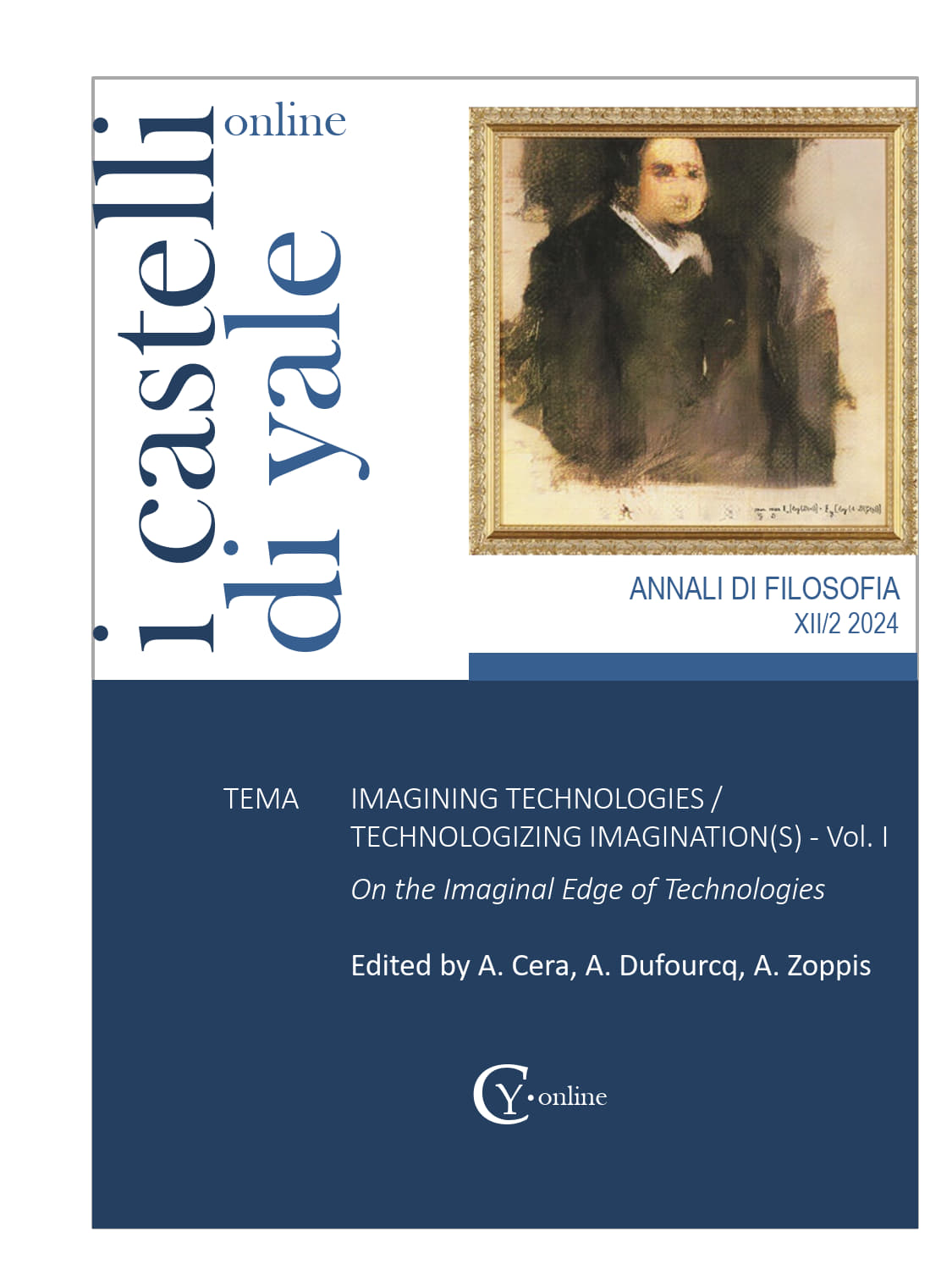What to Do with AI Images?
Towards an Epistemology of Trust
DOI:
https://doi.org/10.15160/2282-5460/2914Parole chiave:
AI, Images, Visual studies, Imaginary, CastoriadisAbstract
The aim of this article is to explore, within the field of visual culture, the ethical and social challenges raised by AI images, the reference imaginaries involved, and the expectations of meaning that arise. The paper will pursue the following line of argument: first, it will examine images that reflect forms of artificial intelligence according to the categories of operative image (i) and invisible image (ii), to investigate the agentive nature of AI images by asking “what do they want from us?” (Romele & Severo 2023) and relate these images to the critical literature that reflects on the concept of “image opératoire”. To elucidate the ways in which technology and the imaginary mutually nourish each other, I will draw on Castoriadis and conceive AI imaginary as both instituted and instituting (Castoriadis 1975), so as to claim a “thoughtful” nature to AI images. This removes them from the stereotypical and numbing forms in which they are usually presented and allows their instituting as well as instituted nature to be imagined in a way that can enable trust in them. This process opens the door to an ethics of the visible that is deeply rooted in the aesthetic regime and situated on an affective level, so to speak.
Riferimenti bibliografici
Aiello, G. (2022). Communication, Espace, Image. Paris: Les Presses du Réel.
Belting, H. (2011). An Anthropology of Images: Picture, Medium, Body. Princeton, NJ: Princeton University Press.
Bredekamp, H. (2010). Theorie des Bildakts. Frankfurt a. M.: Suhrkamp.
Castoriadis, C. (1975). The Imaginary Institution of Society. Engl. Trans. K. Blarney. Cambridge, MA: MIT Press.
Castoriadis, C. et al. (1968). Mai 68: La brèche. Premières réflexions sur les événements. Paris: Fayard.
Castoriadis, C. (1993). The Greek and the Modern Political Imaginary. Salmagundi, 100, 102-129.
Castoriadis, C. (2007). L’immaginaire comme tel. Paris: Hermann.
Cave, S. et al. (2020). AI Narratives: A History of Imaginative Thinking about Intelligent Machines. Oxford: Oxford University Press.
Cave, S. & Dihal, K. (2020). The Whiteness of AI, Philosophy & Technology, 33, 685-703 (https://doi.org/10.1007/s13347-020-00415-6).
Cocchiaro, M. Z. et al. (2024). Who Is an AI Ethicist? An Empirical Study of Expertise, Skills, and Profiles to Build a Competency Framework. SSRN (https://dx.doi.org/10.2139/ssrn.4891907).
Crawford, K. & Paglen, T. (2021). Excavating AI: The Politics of Images in Machine Learning Training Sets. AI & SOCIETY, 36, 1105-1116 (https://doi.org/10.1007/s00146-021-01162-8).
Derrida, J. & Stiegler, B. (2002). Echographies of Television: Filmed Interviews. Engl. Trans. J. Bajorek. Cambridge: Polity Press.
Dorian, M. & Pousin, F. (eds). (2013). Seeing from Above. The Aerial View in Visual Culture. London-New York: I. B. Tauris.
Foster, H. (1988). Vision and Visuality. Seattle, WA: Bay Press.
Foucault, M. (2008). This Is Not a Pipe. Engl. Trans. J. Harkness. Berkeley, CA: University of California Press.
Freedberg, D. (1989). The Power of Images: Studies in the History and Theory of Response. Chicago: University of Chicago Press.
Gell, A. (1998). Art and Agency: An Anthropological Theory. Oxford: Oxford University Press.
Grønstad, A. & Vågnes, Ø. (eds). (2019). Invisibility in Visual and Material Culture. London: Palgrave Macmillan.
Jasanoff, S. & Kim, S-H. (2015). Dreamscapes of Modernity: Sociotechnical Imaginaries and the Fabrication of Power. Chicago: University of Chicago Press.
Lyon D. (2007). Surveillance Studies: An Overview. Cambridge: Polity Press.
Merleau-Ponty, M. (1969). The Visible and the Invisible. Engl. Trans. A. Lingis. Evanston, IL: Northwestern University Press.
Merleau-Ponty, M. (2010). Institution and Passivity: Course Notes from the Collège de France (1954-1955). Engl. Trans. L. Lawlor & H. Massey. Evanston, IL: Northwestern University Press.
Mitchell, M. (2019). Artificial Intelligence: A Guide for Thinking Humans. New York: FSG (Farrar, Straus and Giroux).
Mitchell, W. J. T. (2005). What Do Pictures Want? The Lives and Loves of Images. Chicago: University of Chicago Press.
Noë, A. (2015). Strange tools: Art and Human Nature. New York: Hill and Wang.
Paglen, T. (2014). Operational Images. e-flux Journal, 59; November 2014 (https://www.e-flux.com/journal/59/61130/operational-images).
Rancière, J. (2004). Disagreement: Politics and Philosophy. Engl. Trans. J. Rose. Minneapolis, MN: University of Minnesota Press.
Rancière, J. (2013). The Politics of Aesthetics: The Distribution of the Sensible. Engl. Trans. G. Rockhill. London: Bloomsbury.
Ribeiro, M.T. et al. (2016). “Why Should I Trust You?” Explaining the Predictions of Any Classifier. KDD ‘16 (Proceedings of the 22nd ACM SIGKDD International Conference on Knowledge Discovery and Data Mining), 1135-1144 (https://doi.org/10.1145/2939672.2939778).
Romele, A. (2022). Images of Artificial Intelligence: A Blind Spot in AI Ethics. Philosophy & Technology, 35 (4), 1-19 (https://doi.org/10.1007/s13347-022-00498-3).
Romele, A. & Severo, M. (2023). Que veulent les images de l’IA? Une exploration de la communication scientifique visuelle de l’intelligence artificielle. Sociétés & Représentations, 55 (1), 179-201 (https://doi.org/10.3917/sr.055.0179).
Rose, G. (2010). Visual Methodologies: An Introduction to Researching with Visual Methodologies. Thousand Oaks, CA: Sage.
Taylor, C. (2004). Modern Social Imaginaries. Durham: Duke University Press.
Vernant, J.-P. (1991). Mortals and Immortals: Collected Essays. Ed. F. I. Zeitlin. Princeton, NJ: Princeton University Press.
Wheeler, M. (2022). Entre la transparence et l’intrusion des machines intelligentes. In: T. Reigeluth & S. Benlaksira (eds.), Intelligence artificielle. Que faire de la transparence technique? (Revue de philosophie contemporaine, 2) (13-29). Paris: Vrin.
Downloads
Pubblicato
Fascicolo
Sezione
Licenza
Copyright (c) 2024 Alessandra Scotti

Questo lavoro è fornito con la licenza Creative Commons Attribuzione - Non commerciale - Non opere derivate 4.0 Internazionale.


